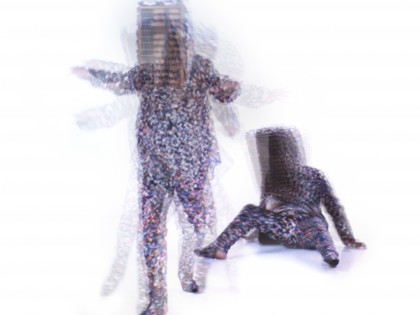Nick Cave might have the answer. He is a collector, a performance artist, a dancer and the creator of Soundsuits — full body-sized sculptures made from a collection of other people’s castoffs.
Cave gathers castoffs from flea markets, antique shops and yard sales: buttons, beads and brass fittings, sequins, toys and old, fraying afghans. Each item he finds holds a story — the energetic imprint from every previous owner, which he assembles into his Soundsuits. In that way, it can be said that Soundsuits are formed from memories.
The Chicago artist’s creations are part sculpture and ornament, armor and instrument and are often worn as costumes and performed in.
The energetic vibration of each single, insignificant article is magnified by how Cave chooses to bind them together. Each found object is transformed through the combination of color, history, function and sound. They force a reaction based on the viewer’s personal history. There is something familiar about the experience of seeing them even for the first time. In a gallery filled with people, this experience becomes a joyful and subversive wake of silent, but collective, sharing.
Art enthusiasts will have the opportunity to experience this wearable art in person. A collection of Cave’s evocative Soundsuits will be on exhibit at the Anderson Collection at Stanford University through Aug. 14, 2017, on loan from the Anderson family, the San Francisco Museum of Modern Art and private collectors.
Cave, who now the director of the graduate fashion program at the School of the Art Institute in Chicago, may not have had the words to describe the latent potency of abandoned objects as a child in Missouri. It is possible, however, the idea that things hold an imprint of all their former lives seeped into his personal identity early on as he accepted hand-me-downs passed to him from his six older siblings.
Cave created his first soundsuit in 1992 as a response to the beating of Rodney King in Los Angeles and the subsequent riots. This suit was made from fallen twigs gathered in Chicago’s Grant Park. He drilled holes in each twig and then sewed them together. His intention was not to create wearable art, but it was only after he slipped the suit of twigs over his head and heard the sound of dry, rattling sticks did Cave experience its power.
His later suits have since evolved “from a dark place to being more about the materials,” said Jason Linetzky, director of the Anderson Collection. “On the surface, they’re fun — but imagine yourself in them.”
The thought-provoking and challenging suits are constructed in ways that refuse to reveal gender, age or race. They offer complete anonymity. To imagine yourself in them is to turn the collective sharing of memories into a personal epiphany.
The Anderson exhibit includes eight Soundsuits, three video works and a recently completed documentary about Nick Cave titled “Here.” There also is an interactive felt wall where visitors to the gallery can help create a trio of two-dimensional soundsuits.
Public programs supporting the exhibition will continue throughout the year. This fall, there will be pop-up family activities in Studio 2 and a mobile art studio parked on the Anderson Collection grounds.
IF YOU GO
What: Nick Cave “Soundsuits”
Where: The Anderson Collection at Stanford, 314 Lomita Drive, Stanford
When: Sept. 14, 2016-Aug. 14, 2017
Wednesday through Monday: 11a.m. to 5p.m. ; Thursday: 11a.m. to 8 p.m.; Closed Tuesday; Public docent-led tours are offered Wednesdays at 12:30 p.m. and on the weekends at 12:30 p.m. and 2:30 p.m.
Cost: Free
Info: Info: anderson.stanford.edu
Freelance writer Mimm Patterson can be emailed at mimmp@mac.com.






